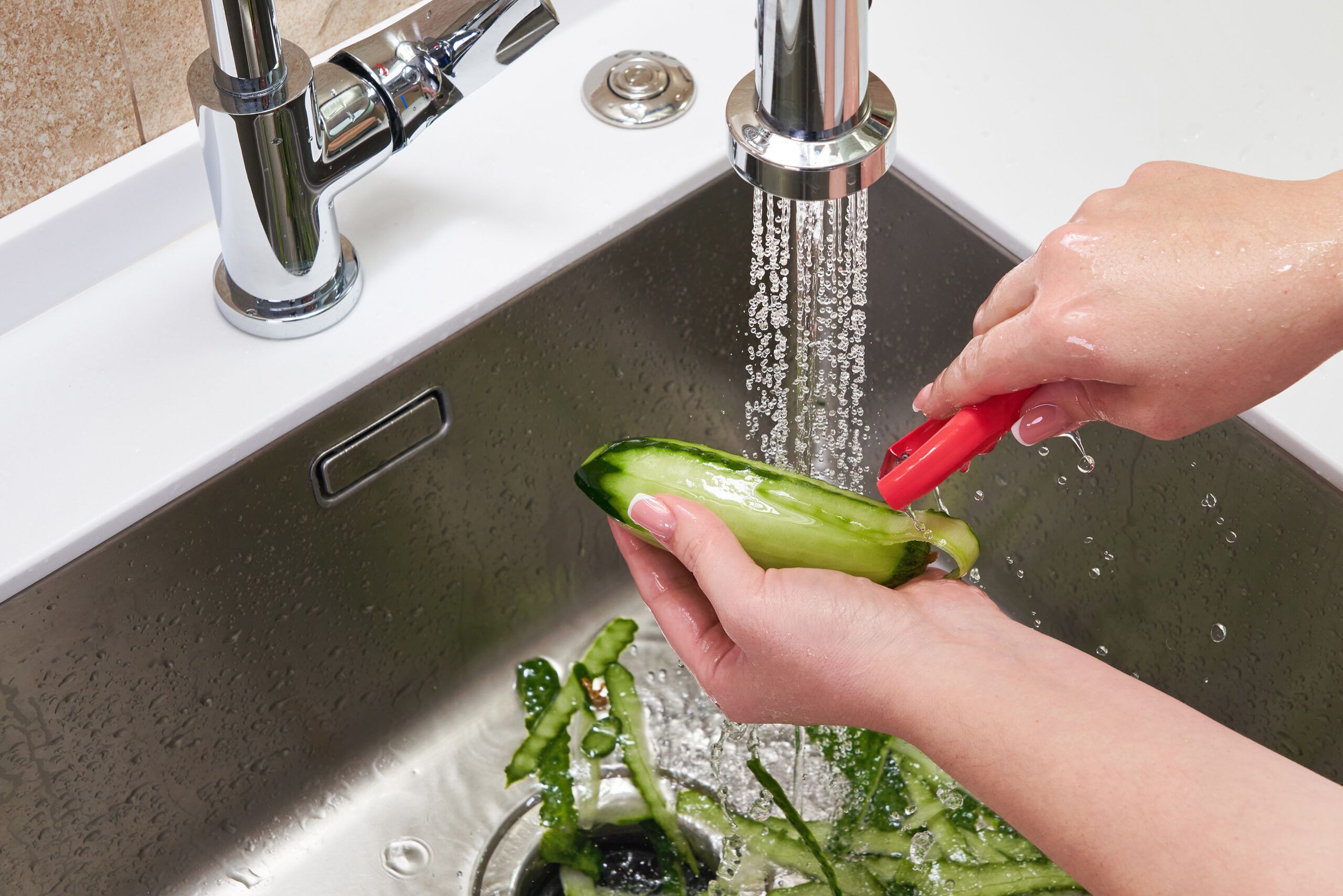How to Clean Garbage Disposal: A Complete Guide for Odor-Free Kitchens
In today’s fast-paced world, the kitchen is the heart of every home, and a clean garbage disposal is essential to maintain a fresh and odor-free environment. You might be dealing with the unpleasant smell emanating from your disposal or have noticed it’s not working as efficiently as before. Fear not! This comprehensive guide will equip you with the knowledge and techniques needed to conquer those garbage disposal woes. Let’s dive in!
Unraveling the Mechanism:
To effectively clean your garbage disposal, it’s crucial to understand how it operates. Garbage disposals are modern marvels that make kitchen cleanup a breeze. They are typically mounted beneath your sink and designed to shred food waste into tiny particles, which are then flushed away with water. There are two main types: continuous feed and batch feed disposals.

Continuous Feed vs. Batch Feed:
Continuous feed disposals run as long as the switch is on, allowing you to add waste continuously. On the other hand, batch feed disposals require a stopper to be placed in the drain before they can run, making them safer but slightly less convenient. Understanding the type you have will help in effective maintenance.
Signs of a Dirty Garbage Disposal
Detecting the Telltale Signs:
Before diving into the cleaning process, it’s essential to recognize the symptoms of a dirty garbage disposal. These signs not only indicate the need for a cleanup but also help you prevent potential problems down the line.
Foul Odors:
One of the most common and unpleasant indicators of a dirty disposal is a lingering, foul odor. If your kitchen sink area has become a source of bad smells, your disposal may be the culprit.
Slow Drainage:
If you notice that your sink is draining more slowly than usual, it could be due to a clogged disposal. Food debris and grease buildup can lead to drainage issues.
Strange Noises:
Unusual grinding or clanking sounds coming from your disposal are red flags. They may indicate foreign objects or debris stuck in the disposal’s grinding mechanism.
Leaks and Rust:
Visual cues like leaks or rust around your disposal unit suggest a need for cleaning and maintenance.
Safety Precautions
Prioritizing Safety First:
Before embarking on your garbage disposal cleaning journey, safety should be your top concern. Follow these essential precautions to ensure a hazard-free process:
Power Off:
Start by turning off the power supply to your garbage disposal. This can usually be done by switching off the circuit breaker or unplugging it. Safety first!
Disconnect Drain Lines:
To avoid accidental splashing and contamination, disconnect any drain lines attached to your disposal. This will provide clear access to the unit without any interference.
Gather Protective Gear:
Equip yourself with safety gear such as gloves and safety goggles. These will shield you from potential splatters and debris during the cleaning process.
Use Appropriate Tools:
Ensure you have the necessary tools like a flashlight and a wrench for dislodging objects stuck in the disposal. This preparedness will make the cleaning process smoother and safer.
By taking these safety measures, you reduce the risk of accidents and ensure a secure cleaning experience.
Cleaning Supplies You’ll Need
Gearing Up for Cleaning Success:
Now that you’re armed with knowledge about your garbage disposal and safety precautions, it’s time to gather the cleaning supplies you’ll need. Here’s a checklist to ensure you have everything ready:
Baking Soda:
A staple in most kitchens, baking soda is a fantastic natural cleaner and deodorizer.
White Vinegar:
White vinegar is another versatile cleaning agent that helps break down grease and grime.
Dish Soap:
Mild dish soap is excellent for cutting through oily residue.
Ice Cubes:
Surprisingly, ice cubes can help dislodge stubborn food particles and debris.
Step-by-Step Cleaning Process
Mastering the Art of Garbage Disposal Cleaning:
Now that you’re well-prepared, it’s time to dive into the step-by-step cleaning process for your garbage disposal. Follow these instructions to restore your disposal to its optimal condition and bid farewell to odors:
Turn Off Power:
Ensure the power to the disposal is completely off before proceeding.
Remove Loose Debris:
Use tongs or pliers to remove any visible debris or objects from the disposal. Be cautious and thorough.
Ice Cube Trick:
Drop a handful of ice cubes into the disposal and run it to help dislodge stubborn residues and sharpen the blades.
Baking Soda and Vinegar:
Sprinkle a half-cup of baking soda into the disposal, followed by a cup of white vinegar. Allow the mixture to fizz and sit for a few minutes to break down grease and eliminate odors.
Hot Water Rinse:
Flush the disposal with hot water to clear away the remaining debris and cleaning solution.
Preventive Maintenance
Guarding Against Future Troubles:
Once your garbage disposal is clean and odor-free, it’s essential to adopt preventive maintenance practices. These measures will help keep your disposal running smoothly and extend its lifespan.
Regular Cleaning Schedule:
Establish a routine for cleaning your disposal, ideally once a month. This proactive approach prevents the buildup of residue and odors.
Use Cold Water:
Run cold water while using the disposal and for a short while afterward. Cold water helps solidify grease, making it easier for the disposal to break down.
Avoid Hard or Fibrous Materials:
Discourage putting hard items like bones or fibrous materials like celery stalks into the disposal. These can cause jams and damage.
Citrus Refresh:
Periodically, grind citrus peels like lemon or orange to maintain a fresh, natural scent in your kitchen.
Troubleshooting Common Problems
Nipping Problems in the Bud:
Even with regular maintenance, issues can still arise. In this chapter, we’ll explore common problems and their solutions:
Jammed Disposal:
If your disposal jams and won’t turn, use an Allen wrench to manually rotate the disposal’s flywheel until it moves freely. Remember to turn off the power before attempting this.
Foul Odors Persist:
If odors linger despite cleaning, grind a mixture of ice and salt to dislodge any stubborn debris. Follow up with citrus peels for a fresh scent.
Persistent Clogs:
For persistent clogs, avoid using chemical drain cleaners. Instead, use a plunger or a drain snake to clear the blockage. Exercise caution to prevent damage.
Unusual Noises:
If you hear strange noises like grinding or clanking, it’s likely due to foreign objects stuck in the disposal. Use tongs or pliers to retrieve the object.
Leaks:
If you notice leaks, tighten the connections or replace worn-out gaskets. Leaks can also result from damaged disposal units, which may require professional repair or replacement.
Frequently Asked Questions (FAQs)
1. Can I use bleach to clean my garbage disposal?
Answer: It’s not recommended to use bleach as it can damage the disposal’s rubber components. Opt for safer, eco-friendly cleaning solutions like baking soda and vinegar.
2. How often should I clean my garbage disposal?
Answer: For optimal performance, clean your disposal once a month or whenever you notice foul odors or slow drainage.
3. Is it safe to put ice cubes in the disposal?
Answer: Yes, ice cubes help clean the blades and dislodge debris. Run them with cold water for effective cleaning.
4. Can I use lemon peels for deodorizing my disposal?
Answer: Absolutely! Lemon peels are a natural deodorizer and can leave your disposal smelling fresh.
5. What if my garbage disposal is jammed?
Answer: Turn off the power and use an Allen wrench to manually rotate the disposal’s flywheel to clear the jam.
6. Should I hire a professional for disposal cleaning?
Answer: It depends on the severity of the issue. Basic cleaning can be done DIY, but if you encounter complex problems, professional help may be necessary.
7. Can I put eggshells in the disposal?
Answer: Yes, eggshells are safe to put in the disposal. They can help clean the blades and freshen the unit.
8. How do I prevent clogs in my garbage disposal?
Answer: Avoid putting fibrous or hard materials like celery stalks or bones into the disposal. Use cold water when running the disposal.
9. What if my disposal is leaking?
Answer: Check for loose connections or damaged gaskets. Tighten connections or replace gaskets as needed.
10. Are there any eco-friendly disposal cleaning methods?
Answer: Yes, you can clean your disposal using eco-friendly solutions like baking soda, vinegar, and citrus peels. These are safe for the environment and effective for cleaning.
Conclusion:
Congratulations! You’ve now mastered the art of cleaning your garbage disposal. With regular maintenance, safety precautions, and eco-friendly cleaning methods, you can enjoy a kitchen that not only looks great but also smells fresh and operates efficiently. Remember, clean garbage disposal is not just about aesthetics—it’s also about maintaining a healthy kitchen environment. By following the steps outlined in this guide, you’ve taken a proactive step toward ensuring your kitchen remains the heart of your home, where meals are prepared, memories are made, and the air is free from unpleasant odors.


